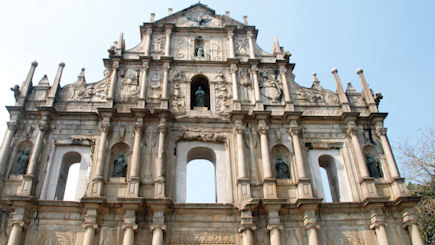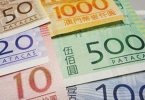This article first appeared in the May/Jun 2016 issue of WGM.
The Ruins of St Paul’s is without doubt the most iconic landmark in Macau. Founded by the Society of Jesus (also known as the Jesuits) in 1583, the ruins are what remain of St Paul’s College and the Church of St Paul. In 2005, it was listed as a UNESCO World Heritage site together with other cultural relics in the Historical Centre of Macau and it is the soul of the Historical Centre.
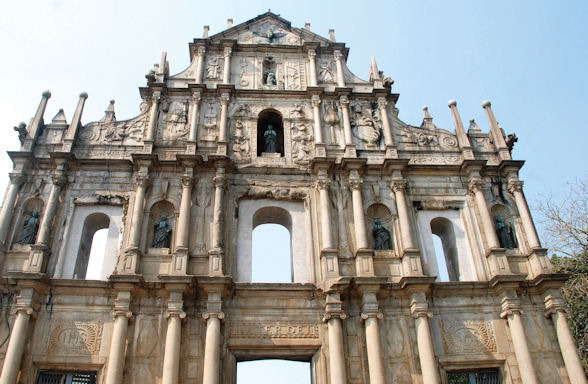
In other words, if you haven’t visited the Ruins of St Paul’s you can’t really say you have visited Macau! However, visiting is one thing – appreciating its historical significance is another altogether. In fact, be it exploring the site’s historical stories, understanding the spread of Catholicism in China or simply appreciating this “giant stereoscopic Bible” that combines both Chinese and Western elements from an artistic point of view, there is much more to the Ruins of St Paul’s than simply a nice photo opportunity (it is said that the Ruins have lots of carvings about stories in the Bible, so appreciating the building is like reading the Bible).
![[b]A carving of the Holy Mother trampling a seven-headed dragon[/b]](http://www.wgm8.com/wp-content/uploads/2016/04/images_wgm_1041_the-ruins-of-st-pauls-2.jpg)
The Ruins of St Paul’s was originally the affiliated “Church of St Paul” of the first western university, St Paul’s College in China. The college was established by the Jesuits in 1594 and ended in 1762. Besides theology, Latin, Chinese and Japanese, its academic program also included seven liberal arts – grammar, rhetoric, dialectics, astronomy, arithmetic, geometry and music. It cultivated a large number of talented missionaries to go to Japan, China, Vietnam, Thailand, Cambodia and other places to preach. Education and missionary work side by side has been one of the major work philosophies of the Jesuits since its establishment in 1540. Macau scholar Mr Xiangyu Li once referred to the college as the “cradle of the Far East missionaries.”
![[b]A Chinese stone flag clip[/b]](http://www.wgm8.com/wp-content/uploads/2016/04/images_wgm_1041_the-ruins-of-st-pauls-3.jpg)
The college and the church suffered two fire disasters in 1595 and 1601. It was rebuilt in 1602 from a design by Jesuit missionary Carlos Spinola. What we see today is the remaining stone façade, 68 stone steps at the front and the foundation at the back after another fire disaster in 1835. The Chinese call it 大三巴牌坊. 三 巴is the transliteration of the Portuguese name of the church of São Paulo; 大means it is the biggest church; while 牌坊means “memorial arch” because the façade looks similar to a Chinese traditional arch.
Participation of Japanese Artisans
The craftsmanship of the Church of St Paul is superb. The construction cost when it was built centuries ago was as high as 30,000 taels of silver (around HK$25 million by today’s standards). Macau was therefore called the “Oriental Vatican.” The design of the church broke with Western tradition in many aspects, adding oriental elements and reflecting the intention to preach in the East. First of all, the church changed the tradition of European churches of facing west (because the Holy Land is to the east of Europe) to face south, with the main altar facing north in order to cater to the Chinese thinking.
![[b]The Ruins of St Paul's is located at Largo da Companhia de Jesus (Company of Jesus Square)[/b]](http://www.wgm8.com/wp-content/uploads/2016/04/images_wgm_1041_the-ruins-of-st-pauls-4.jpg)
In the past, people’s knowledge was limited and most of them were illiterate. You will find a large number of bas-relief sculptures on the ruins to convey the doctrine.
The Ruins of St Paul’s façade is divided into five tiers from the top down. If you observe carefully, you will find the cross that symbolizes redemption at the very top is not completely vertical but slightly tilted to the East, symbolizing the channel from the earth to heaven. The first and second tiers represent heaven. In the second tier there is a statue of Jesus in the middle. The chrysanthemums at the bottom of both sides are holy to the Japanese. During the construction of the church, the Japanese government banned the increasingly large Catholic contingent and expelled missionaries, so many Japanese missionaries came to Macau to take refuge and participated in the construction of the church. This is why traces of the Japanese artisans’ craftsmanship can be found on the arch. There is a lion-shaped water outlet at each end of this tier.
The Four Saints of the Jesuits
There are four shrines at the fourth tier of the façade from west to east, or from left to right if you are facing the façade, dedicated to the four Saints of the Jesuits.
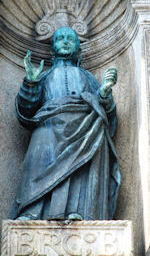
1. Saint Francis Borgia
Saint Francis Borgia was born in the Duchy of Gandía near Valencia, Spain in 1510. With his prominent family background, he became Viceroy of Catalonia and Duke of Gandía. However after the death of his wife in 1546 he abandoned all fame and fortune to join the Society of Jesus. He became the third Superior General of the Society of Jesus on 2 July 1565. Under his leadership, its influence reached throughout Europe and overseas. He died in 1572, was beatified in 1634 and eventually canonized in 1671.
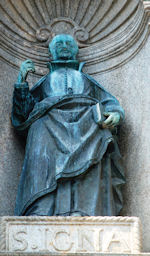
2. Saint Ignatius of Loyola
Born into the Basque noble family at the castle of Loyola in Spain in 1491, Saint Ignatius of Loyola was an equerry to the King as a teenager. In 1521 he broke his legs while defending the Spanish fortress of Pamplona and it became the turning point in his life. He abandoned power and wealth and began his journey of Spiritual Exercises, writing the famous book of the same name. Later he founded the Society of Jesus with six others in Paris and became the first Superior General of the Society of Jesus. He died in 1556 and was canonized in 1622. He is the Patron Saint of all spiritual exercises.
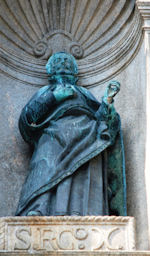
3. Saint Francis Xavier
He was born in the Castle of Xavier in Navarre, Spain in 1506. Later he went to study in Paris where he met Saint Ignatius of Loyola and co-founded the Society of Jesus. He was the first Jesuit to do missionary preaching in the Far East. He left his footprint in Goa, India; Ceylon (now Sri Lanka); Malacca (today’s Malaysia) and Japan. Unfortunately he died on Shangchuan Island near Macau in 1552 while waiting to enter mainland China. He was canonized in 1622 and is the Patron Saint of foreign missionaries. His arm bones were kept in St Joseph’s Seminary and Church in Macau for followers to worship.
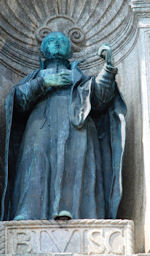
4. Saint Aloysius Gonzaga
Saint Aloysius Gonzaga was born at his family’s castle in Castiglione della Stiviere in Lombardy, Italy in 1568. When he was 18, he left his life of Italian aristocracy behind and joined the Society of Jesus. In 1591, a plague ravaged Rome. He became infected with the disease when he was caring for the sick and died at the age of only 23. He was beatified in 1605 and canonized in 1726. He is the Patron Saint of young students and teenage followers.
Inscriptions in Chinese characters
The third or middle is the most abundant and important tier. In the middle is the statue of the Holy Mother, Mother Mary, which is the intermediary of the earth and heaven. There are six angels on both sides of the Holy Mother. Although the content is western, there are distinctively oriental decorative motifs such as the auspicious clouds (symbolizing good luck in Chinese culture) that the four angels in the middle and bottom are standing on.
There are also three groups of Chinese stone inscriptions that are often overlooked. On the west side of the Holy Mother, the Chinese characters are 鬼是诱人为恶meaning “ghosts lure people to do evil things.” There is a fierce-looking demon with a tail and wings on its back carved besides the characters. It has a female body with prominent breasts and it has been shot with an arrow. Along with the accompanying characters, it illustrates that the devil, which represents all kinds of temptations, induces people to commit crimes but was eventually defeated.
On the east side, the Chinese characters are 念死者无为罪. Beside the characters, you can see a skeleton lying on a sickle and with an arrow stabbing into the body. This is to remind people that death can happen to us at any time, so we must constantly stay away from sin.
![[b]The Catholic Art Museum[/b]](http://www.wgm8.com/wp-content/uploads/2016/04/images_wgm_1041_the-ruins-of-st-pauls-9.jpg)
The third group of Chinese characters, also on the eastern side, is 圣母踏 龙头meaning the Holy Mother tramples the heads of the dragon. The carving besides the characters is the Holy Mother trampling a vicious seven-headed dragon with wings. The dragon has scales similar to Chinese dragons on its body. The seven heads represent the seven deadly sins in Catholicism – pride, wrath, envy, lust, gluttony, sloth and greed. Inscriptions in Chinese characters on a Catholic church had never happened before, giving it a strong Chinese influence. There is also a lion-shaped water outlet at each end of this tier.
Immortal holy history
The fourth and fifth tiers and the stone steps underneath represent the earth. Being the entrance, the fifth tier has three gates. The entrance in the middle has “MATER DEI” (meaning Mother of God) carved into it. The two entrances on each side have “IHS” (the sign of the Jesuits, meaning the savior Jesus Christ) carved on top decorated with bas-reliefs, allowing followers who want to be saved to enter. Today, the soul of the ruins is still there. It reflects the localization of the Jesuits and is important evidence of developing Catholic territory in the East.
After appreciating the exquisite façade, you can go to the back to see the tomb of the founder of St Paul’s College, Father Alexander Valignano, and the Catholic Art Museum. At the left front of the ruins there is a Chinese stone flag clip where flags granted to Jesuits by the Chinese empires as a prize or honor were once displayed. At the left back, there is a traditional Chinese Na Tcha Temple. These two constitute an interesting picture of Chinese and Western architecture, adding radiance and beauty to each other. Finally, as a friendly reminder, if you really like this place, don’t forget to keep a MOP$5 coin or a MOP$20 note issued by the Bank of China while you are in Macau, because the picture of the Ruins of St Paul’s is printed on one side. It is more authentic than any souvenir!

